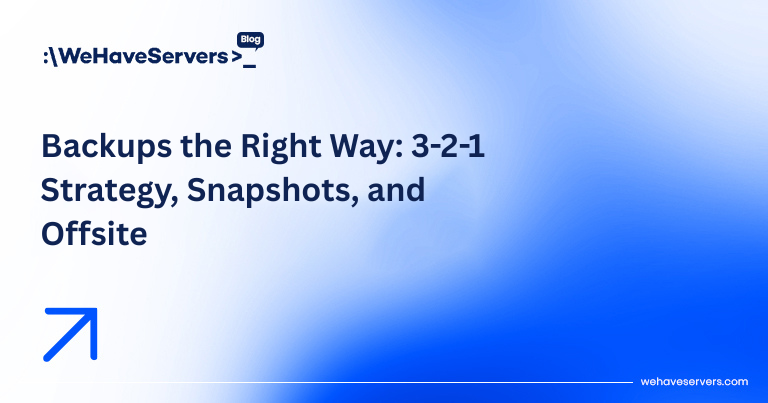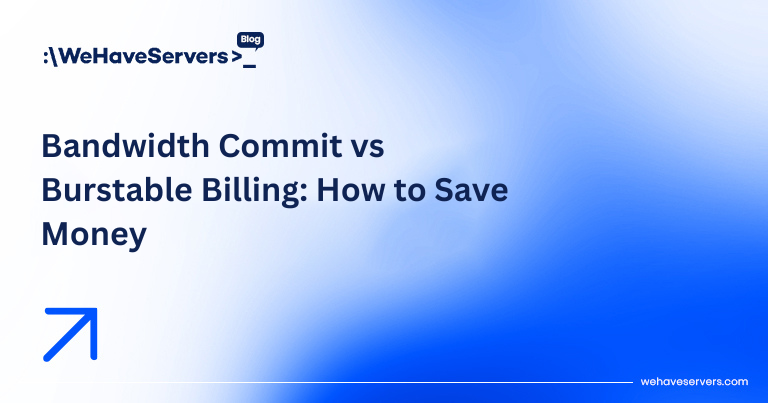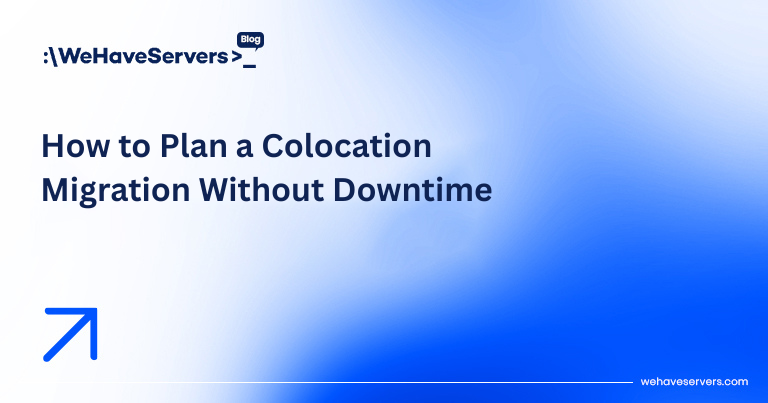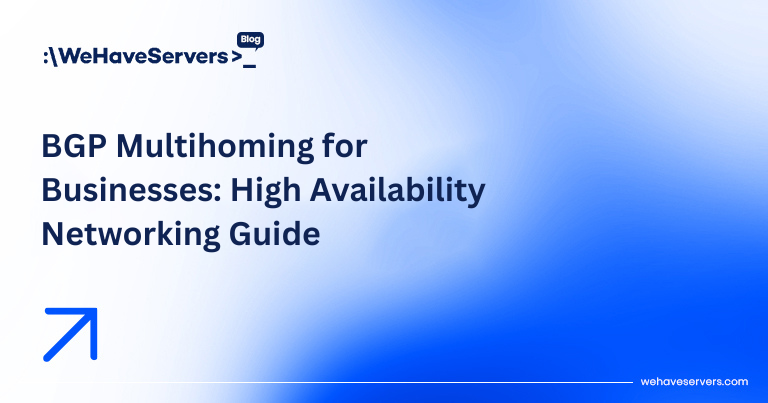
Backups the Right Way: 3-2-1 Strategy, Snapshots, and Offsite
Backups the Right Way: 3-2-1 Strategy, Snapshots, and Offsite
In 2025, data is everything. Whether you’re running a SaaS startup, a WordPress e-commerce site, or a financial trading platform, a single mistake, hardware failure, or ransomware incident can wipe out years of business data. The only real insurance is a robust backup strategy. Yet too many teams still rely on “hope and pray” methods — a single backup on the same disk, or worse, none at all.
This guide explains how to implement backups the right way. We’ll cover the classic 3-2-1 strategy, the role of snapshots, why offsite replication is essential, and which tools and practices advanced sysadmins use to guarantee data safety. By the end, you’ll have a blueprint for bulletproof backups on VPS, dedicated servers, or colocation infrastructure.
🔹 The 3-2-1 Backup Strategy
The 3-2-1 rule remains the gold standard:
- 3 copies of your data (1 production + 2 backups).
- 2 different media types (e.g., local disk + cloud storage).
- 1 offsite copy (geo-redundant).
Example for a VPS hosting WordPress:
- Copy 1: Production data on NVMe SSD.
- Copy 2: Daily local snapshot on provider’s storage array.
- Copy 3: Nightly rsync to an S3-compatible object store (offsite).
Why it works: Protects against disk failure, ransomware, provider outage, and even full datacenter loss.
🔹 Snapshots: Fast but Not Enough
Snapshots are point-in-time copies of a disk or VM. They are useful but have limits:
Advantages:
- Instant creation, minimal performance impact.
- Perfect for fast rollback during updates/patching.
- Integration with hypervisors (VMware, KVM, Proxmox) and cloud (AWS EBS, GCP PD).
Limitations:
- Stored on the same infrastructure → if array fails, snapshots are lost.
- Not a replacement for true backups.
- Performance penalty if snapshots are long-lived (copy-on-write chains).
Rule: Snapshots are for short-term safety, not disaster recovery.
🔹 Offsite Backups: The Lifeline
Offsite copies are the only way to survive catastrophic failures (fire, flood, ransomware in provider network).
Options in 2025:
- Object Storage (S3, MinIO, Backblaze, Wasabi): Cheap, scalable, API-driven.
- Remote rsync/rclone: Push backups over SSH to remote server or NAS.
- Tape (LTO-9/10): Still viable for enterprise archival, 18–36 TB per tape.
- Multi-cloud: Store copies across AWS, Azure, GCP, or smaller EU providers for GDPR compliance.
🔹 Backup Frequency & Retention
The right schedule balances recovery point objectives (RPO) vs storage cost:
- Hourly backups: For databases or fast-changing apps (e.g., SaaS).
- Daily backups: Standard for most VPS workloads.
- Weekly/monthly archives: Long-term retention for compliance.
Best practice: GFS rotation (Grandfather-Father-Son). Example:
- 7 daily snapshots
- 4 weekly full backups
- 12 monthly archives
🔹 Backup Tools in 2025
- BorgBackup: Deduplication + compression. Excellent for VPS backups to remote repo.
- Restic: S3-compatible, encrypted, incremental backups.
- Velero: Kubernetes-native backup/restore.
- Proxmox Backup Server (PBS): Enterprise-grade deduplication + incremental VM backups.
- Veeam: Still the enterprise standard for VMware/Hyper-V.
🔹 Automation Scripts (Examples)
Borg + rclone Offsite Backup
#!/bin/bash
BACKUP_REPO=/mnt/backups/borg
OFFSITE_REMOTE=wasabi:mybucket/server1
borg create --stats $BACKUP_REPO::"$(date +%F-%H%M)" /var/www /etc /home
borg prune -v --keep-daily=7 --keep-weekly=4 --keep-monthly=12 $BACKUP_REPO
rclone sync $BACKUP_REPO $OFFSITE_REMOTE
MySQL Hot Backup with Percona XtraBackup
xtrabackup --backup --target-dir=/backups/mysql/$(date +%F) --parallel=4
🔹 Testing Backups (Most Forgotten Step)
Backups are worthless if untested. Best practices:
- Automate nightly restore tests into a staging environment.
- Verify checksums of backed-up data.
- Document recovery runbooks — who restores, how, where?
Rule: A backup you haven’t tested is just a hope.
🔹 Disaster Recovery Integration
Backups are part of a bigger Disaster Recovery (DR) plan:
- RPO (Recovery Point Objective): How much data loss is acceptable? (e.g., 1h).
- RTO (Recovery Time Objective): How fast must you recover? (e.g., 15m).
- Runbooks: Documented recovery process tested quarterly.
Enterprise-grade setups combine:
- Snapshots (fast rollback)
- Incremental backups (low storage cost)
- Geo-redundant replication (full disaster recovery)
🔹 Case Studies
Case 1: VPS with Local Only Backups
- Customer relied on provider snapshots.
- RAID array failure destroyed snapshots + production.
- Business lost 3 months of data.
Case 2: SaaS with 3-2-1 Strategy
- Local ZFS snapshots every 15 min.
- Nightly rclone sync to S3-compatible storage.
- Quarterly restores verified in staging.
- No data loss during ransomware incident — restored within 30 min.
✅ Conclusion
Backups are not optional. The right strategy blends snapshots, offsite copies, and automation into a 3-2-1 plan that aligns with business RPO/RTO targets. In 2025, ransomware, hardware failures, and cloud outages are inevitable — but data loss doesn’t have to be.
At WeHaveServers.com, we provide enterprise-grade VPS and dedicated hosting with built-in snapshot options, offsite backup integrations, and support for S3-compatible storage, ensuring your workloads are always recoverable.
❓ FAQ
Are snapshots the same as backups?
No. Snapshots are stored on the same infrastructure and don’t protect against full storage array failure or ransomware.
How often should I back up?
Depends on workload. For dynamic databases, hourly backups are recommended. For static sites, daily may suffice.
What’s the cheapest offsite backup option?
S3-compatible object storage (Backblaze, Wasabi, MinIO) is cost-effective, reliable, and easy to automate.
Do I need encryption for backups?
Yes. Always encrypt offsite backups (Borg, Restic, rclone all support this).
How do I test backups?
Automate restores into staging. At minimum, verify checksums monthly to ensure data integrity.



